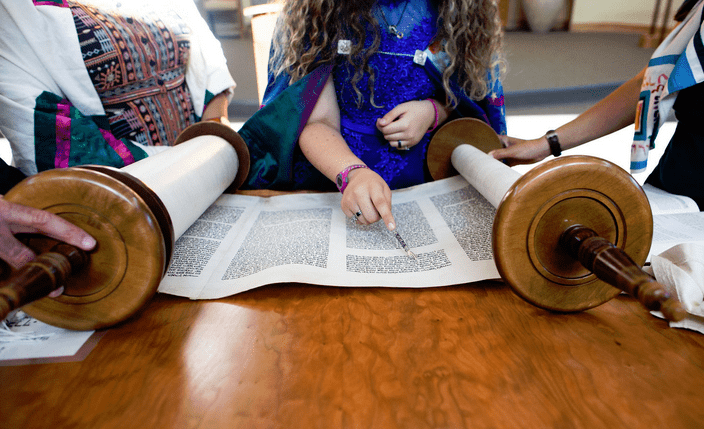Becoming B’nai Mitzvah

Many Talmud Torah students will choose to become b’nai mitzvah at TBI. Our goal is for our b’nai mitzvah students to be able to confidently declare “Hineini!” (“Here I am!”) and understand and demonstrate what it means to them personally to be a Jewish adult. This may look different for each student. They are all encouraged to focus on one or more of the following pathways to Jewish literacy and identity as they choose their course of study during their years in Talmud Torah.
(Mind) Torah
Includes Torah study and analysis, learning Hebrew, and a clear understanding of the key stories and themes in Judaism.
(Heart) Avodah
Focuses on fluency and ease with songs and blessings used in services and everyday life so that students are able to confidently lead parts of services, and be actively Jewish in daily life.
(Hands) G’milut Chasidim
Features learning about Jewish values and ethics including tikkun olam efforts and mitzvot-based activities.
(Body) K’lal Israel
Explores what makes Jews “a people,” including cooking, cultural traditions, crafts, Jewish history, Israel, and/or contemporary Jewish issues.
To become b’nai mitzvah at TBI, students must be at least 13 and have participated actively in Talmud Torah for at least 6th and 7th grades by taking a combination of Sunday morning Cohort, Hebrew and JEWL classes (see the Talmud Torah Learning & Curriculum page for more information about those classes).
We recommend that students begin with our Sunday morning cohort class in preschool or kindergarten to build community and then, beginning in second grade, take Hebrew and JEWL classes as well as cohort to work towards becoming b’nai mitzvah-ready. Some of our students will be ready to become b’nai mitzvah at 13. Some will be ready at 14 or even older, and that’s okay. They may continue taking classes until they are ready to do so. Students are ready to be called to the Torah and become b’nai mitzvah when they know what it means to them to be Jewish and have enough foundation for continued learning to make saying “Hineini” meaningful.
New students to Talmud Torah will not start in Kita Vav (6th grade) or Zayin (7th grade), regardless of age (unless they have participated in religious school elsewhere).
Families may request dates for b’nai mitzvah services in the summer prior to Kita Vav (6th grade). Students are assigned dates for their b’nai mitzvah services by that late summer/early fall after meeting with the religious school director and submitting the necessary paperwork. We do not accept requests or assign dates before that time.
The Talmud Torah office tracks student progress and communicates this to parents three times a year during Kita Vav and Zion. Students who are not making appropriate progress and/or showing committed participation will likely be asked to postpone b’nai mitzvah dates.
You can view detailed information about all things related to the b’nai mitzvah program in the B’mitz Family Handbook.
B’nai Mitzvah Program ““ Forms and Resources
- The B’mitz Family Handbook (2023 edition)
- B’nai Mitzvah Studies Agreement and B’nai mitzvah entrance form. (The is agreement is the standard one. Students and families may work with the Talmud Torah office to modify it as necessary.)
- B’nai Mitzvah 2-year timeline
- B’nai Mitzvah Fees
- Service Attendance Requirements: Please use the paper Tracker Form found here to track your attendance and participation in services, Prayers UnPacked sessions, and other TBI events. We also highly encourage you to use this Online Tracker so that the Talmud Torah office can help you keep track as well.
- Sound files for the prayers and blessings students will be learning.
- B’nai Mitzvah Student Liturgy Practice Book (contains all the prayers and blessings required for B’nai Mitzvah students) including a TBI trope insert especially helpful for students who have music reading skills.
- A useful calendar and date converter for figuring out Hebrew birthdays, parshiot, and other relevant information.
- Looking for parsha commentary?
- Talmud Torah recommends My Jewish Learning’s site. They have links to many resources for each week’s portion.
- The JRC (Jewish Reconstructionist Communities) also has a good collection of divrei Torah for each parsha.
- Interested in using your b’nai mitzvah to help with Holocaust Remembrance? Check out this excellent organization Remember Us that helps today’s b’nai mitzvah students honor children who died in the Holocaust.
- Honors List: The form parents fill out indicating which friends and relatives will be receiving various honors during the b’nai mitzvah. You can download an excel version that you can fill in electronically from our b’nai mitzvah Google drive.
- Building Use Form: Parents must use this form to inform the office staff of any planned uses of the building events related to b’nai mitzvah (kiddush, luncheon, dinner, party) before or after b’nai mitzvah.
- Caterer Handout: A handy guide with explanations of TBI kitchen policies to give anyone helping with food prep for your family’s event.
- B’Mitzvah Program Template (the handout that many families choose to make to give people at the service) – Download and print (flip on short edge!)